Meteorização
É o conjunto de processos físicos e químicos que
levam à decomposição ou desintegração de rochas e solos.
De um modo geral, a meteorização ocorre com uma
lentidão extraordinária e a duração da vida humana não é
suficientemente longa para que se consiga acompanhar e observar na
Natureza esse fenómeno.
É importante distinguir os
conceitos de meteorização e de erosão. Os
processos de meteorização alteram as características
primárias das rochas; a erosão corresponde ao conjunto de processos
físicos, que permitem remover os materiais resultantes da
meteorização. A meteorização ajuda a fragmentar as rochas em
pequenas porções, que, posteriormente serão
erodidas.
Em resumo, a
meteorização é o fenómeno natural a que estão sujeitos todos os
materiais geológicos quando expostos à ação combinada da atmosfera,
da hidrosfera, da biosfera e da antroposfera, ocorrendo de forma
permanente em toda a superfície terrestre.
Tipos de
meteorização
Existem dois tipos de Meteorização: Meteorização
Física/Mecânica eMeteorização
Química.
METEORIZAÇÃO
QUÍMICA
A meteorização química resulta de reações químicas
entre os minerais das rochas, o ar e a água, verificando-se assim
uma alteração quer na composição química quer na composição
mineralógica; alguns minerais são destruídos e outros são formados
com estruturas cristalinas mais estáveis nas condições que dominam
na superfície terrestre.
As reações mais típicas da meteorização química são
as seguintes:
-Oxidação/Redução
Os processos de oxidação e de redução estão ligados
entre si: a oxidação não ocorre sem a redução e vice-versa. A
oxidação é o processo pelo qual um átomo ou um ião perde electrões;
na redução ocorre um ganho de electrões.
Este processo é especialmente importante na
meteorização de minerais, com teores de ferro elevados.
O processo que leva à formação da ferrugem,
substância de cor vermelha acastanhada é o resultado da
transformação do Fe2+ em Fe3+
4FeO+O2→2Fe2O3
Outros exemplos são a transformação da pirite em
hematite e da piroxena em limonite.
4FeS2+3O2→2Fe2O3+8S
(pirite)
(hematite)
2(Fe2+)2Si2O6+O2+14H2O→4Fe3+(OH)3+4H4SiO4
(piroxena) (limonite)
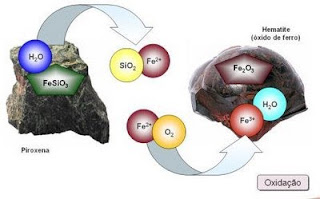
-Hidrólise
A hidrólise é uma reação química lenta e especifica
definida como sendo uma substituição dos catiões da estrutura de um
mineral pelos iões de hidrogénio. Estes iões podem vir a da água ou
de um ácido. Esta reação de substituição iónica leva à formação de
novos e diferentes minerais ou à completa desintegração do mineral
original.
Os minerais, como por exemplo a olivina e a piroxena
são totalmente desintegrados.
Mg2SiO4+4H+→2Mg2++H4SiO4
(olivina)
CaMgSi2O6+4H++2H2O→Ca++Mg2++2H4SiO4
(piroxena)
Os minerais especialmente os feldspatos dissolvem-se
parcialmente produzindo sílica dissolvida e minerais de
argila.
2KASi3O8+H2CO3+H2O→K2CO3+Al2Si2O5(OH)4+4SiO2
(feldspato)
(argila)
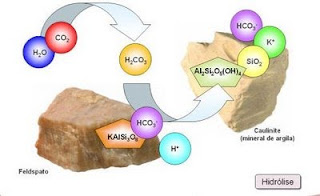
-Dissolução
Processo de meteorização, no qual ocorre a reação
dos minerais com a água ou com um ácido. A ligação entre os
diferentes iões é quebrada e os iões ficam dissolvidos numa
solução.
A halite é um mineral extremamente solúvel, quando
comparado com o quartzo. Ao colocar halite na água obtemos água
salgada com iões de sódio e cloro dissolvidos.
NaCl+H2O→Na++Cl-
(halite)
-Hidratação/Desidratação
Este processo de meteorização envolve a combinação
química de minerais com a água (hidratação) ou com a sua remoção de
outros (desidratação). No caso da desidratação, ocorre um aumento
de volume que facilita a desintegração das rochas por ação da
hidrólise.
Hidratação da hematite para formar
limonite.
Fe2O3+3H2O→2Fe(OH)3
(hematite) (limonite)
Desidratação do gesso para formar
anidrite.
CaSO4.2H2O→CaSO4+2H2O
(gesso)
(anidrite)
Reflexão:
Esta meteorização pode ocorrer de duas maneiras
distintas.
-Os minerais são dissolvidos completamente, a
exemplo da calcite ou halite, e, posteriormente, podem precipitar
formando os mesmos minerais.
-Os minerais são alterados, a exemplo dos feldspatos
e micas, e, posteriormente, formam os novos minerais,
especialmente, minerais de argila.
Estas reações ocorrem mais facilmente na presença da
água e do ar atmosférico.
Meteorização
Física/Mecânica
A meteorização física/mecânica inclui os diversos
processos que fragmentam a rocha em pedaços cada vez mais pequenos
sem que, no entanto, ocorram transformações químicas que alterem a
sua composição, neste tipo de meteorização incluem-se processos,
tais como a ação da água, a ação do gelo, a ação do calor, a ação
dos seres vivos, o crescimento de minerais e o alívio de
pressão.
Os mais importantes tipos de
meteorização mecânica são:
-Meteorização por alívio de
pressão
A redução de pressão
sobre uma massa rochosa pode causar a sua expansão e posterior
fragmentação. As rochas que se formam em profundidade sob grande
pressão, a exemplo das rochas magmáticas plutónicas, quando são
aliviadas do peso das rochas suprajacentes, expandem, fracturam e
formam diáclases.
Por vezes este alívio de pressão provoca o
aparecimento de capas algo semelhante a escamas de cebola, este
processo designa-se por disjunção esferoidal.

-Meteorização pela ação do gelo
ou Crioclastia
Por diminuição da temperatura a água que penetra nas
fracturas e nos poros da rocha, pode gelar. A água ao mudar de
estado líquido para o estado sólido expande-se e o seu acréscimo de
volume exerce forças que aumentam as fissuras já existentes ou
originam novas fissuras, contribuindo, deste modo para a
desagregação da rocha.

-Meteorização pela
ação do calor ou termoclastia
Todos os corpos sofrem variações no seu volume
provocadas por variações de temperatura. As rochas são constituídas
por minerais diferentes, que se comportam de modo diferenciado
quando expostos a variações de temperaturas.
Em regiões com fortes
amplitudes térmicas diárias, a exemplo do que ocorre nos desertos
quentes e secos, onde a temperatura pode oscilar entre os 40ºC
positivos e os 20ºC negativos, esta variação, por vezes muito
brusca, implica uma variação do volume das rochas. Um aumento de
temperatura implica dilatação; um arrefecimento implica a
contração. Este movimento sistemático, provocado por grandes
amplitudes térmicas, leva a uma grande fracturação das rochas com a
formação de materiais soltos.
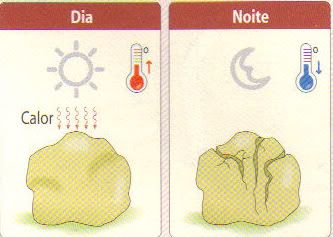
-Ação da
atividade biológica/seres vivos
As sementes germinam em fendas das rochas,
originando plantas cujas raízes se instalam nessas fendas,
abrindo-as cada vez mais e contribuem assim para a separação dos
blocos. Também os ventos, fazendo balançarem as árvores que levam
ao alargamento das fendas das rochas onde estão implementadas,
facilitando, desta forma, a ação de outros agentes de
alteração.
Por vezes certos animais como coelhos, texugos,
minhocas e formigas também são responsáveis pela desagregação da
rocha, ao cavar tocas ou galerias que aumentam o grau de degradação
da rocha ou expõem, ainda mais, as rochas a outros agentes de
meteorização.
-O Vento
A projeção de areias finas sobre os blocos rochosos
intensifica a fragmentação da rocha, funcionando como uma
lixa.
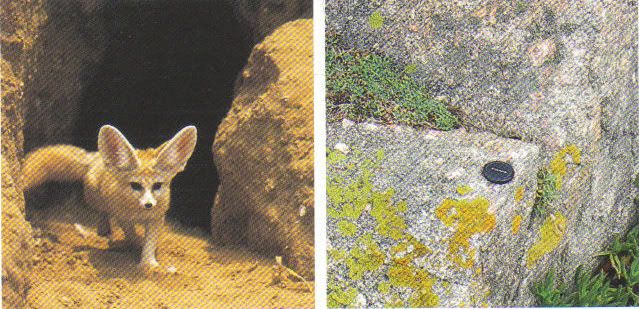
-Crescimento de minerais ou
haloclastia
Por vezes, a água que existe nas fracturas e poros
das rochas contém sais dissolvidos, que podem precipitar e iniciar
o seu crescimento exercendo, assim, uma força expansiva, que
contribui para uma maior desagregação das rochas. Um exemplo que
ocorre nas áreas costeiras é o crescimento de cristais do mineral
halite.
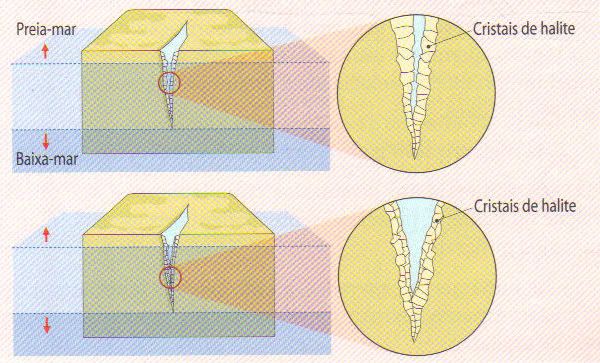
-Ação da
água
A água constitui o mais
importante factor de alteração das rochas. A alternância de
períodos secos com períodos de forte humidade, resultantes da
variação cíclica dos teores de água das rochas, originam aumentos
de volume e retrações, gerando tensões que conduzem à fracturação
e, eventualmente, à desagregação do material rochoso. A própria
ação da água da chuva sobre as rochas também contribui para a sua
meteorização.
-Ação da água do
mar
O impacto das ondas sobre as arribas é o principal
responsável pela fragmentação destas.
“Água mole em
pedra dura tanto dá até que fura.”
Reflexão:
A meteorização física/mecânica pode resultar de
vários factores, verifica-se desde já que a água desempenha um
papel muito importante a este nível, pois pode provocar a expansão
das fracturas contribuindo para a desagregação da rocha. Pode-se
também concluir que as rochas que sofrem meteorização física
aceleram a meteorização química!
Depois de visitar o local e de ter lido toda esta
informação para logar esta Earthcache só tem de responder às
seguintes questões…
1-
Qual a orientação da
fractura na rocha(exemplo: Sul, Este…)?
2-
Qual a altitude
aproximada no ponto zero?
3-
Qual o tipo de árvore
que predomina no local nome pelo qual é conhecido e em
latim?
4-
Que tipo de
meteorização terá sofrido a rocha e por ação de que?
5- Qual o Percurso
Pedrestre que passa no local da cache e o seu nome?
[EN]
Weathering
Weathering is the set
of physical and chemical processes that lead to decay or
disintegration of rocks and soils.
In General, the
weathering occurs with an extraordinary pace and duration of human
life is not long enough to be able to monitor and observe in nature
this phenomenon.
It is important to distinguish the concepts of weathering
and erosion. The processes of weathering alter the primary
characteristics of the rocks; erosion is the set of physical
processes, which allow you to remove the materials resulting from
weathering. The weathering helps fragment rocks in small portions,
which subsequently will be eroded.
In summary, the
weathering is the natural phenomenon to which they are subject all
geological materials when exposed to the combined action of the
atmosphere, hydrosphere, biosphere and permanently antroposfera,
occurring throughout the Earth's surface.
Types of weathering
There are two types of
Weathering: Physical/mechanical Weathering and
Chemical
Weathering
CHEMICAL WEATHERING
The chemical
weathering results from chemical reactions between minerals of the
rocks, air and water, so a change in chemical composition both in
mineralogical composition; some minerals are destroyed and others
are formed with crystal structures more stable under the conditions
that dominate in the Earth's surface.
The most typical
chemical weathering reactions are as follows:
-Oxidation/Reduction
Processes of oxidation
and reduction are linked together: the oxidation does not occur
without the reduction and vice versa. Oxidation is the process by
which an atom or an ion loses electrons; the reduction occurs a
gain of electrons.
This process is
especially important in weathering of minerals with high iron
levels.
The process that leads
to the formation of rust, brownish red color of substance is the
result of the transformation of Fe2+ in Fe3+
4FeO+O2→2Fe2O3
Other examples are the
transformation of pyrite in hematite and limonite in
pyroxene
4FeS2+3O2→2Fe2O3+8S
(pirite)
(hematite)
2(Fe2+)2Si2O6+O2+14H2O→4Fe3+(OH)3+4H4SiO4
(piroxena) (limonite)
-Hydrolysis
Hydrolysis is a
chemical reaction slow and specifies defined as being a replacement
of the cations of the structure of a mineral by hydrogen ions.
These ions can come to the water or an acid. This ion replacement
reaction leads to the formation of new and different minerals or
the complete disintegration of the original mineral.
Minerals such as
olivine and pyroxene are totally disintegrated.
Mg2SiO4+4H+→2Mg2++H4SiO4
(olivina)
CaMgSi2O6+4H++2H2O→Ca++Mg2++2H4SiO4
(piroxena)
Especially the
feldspar minerals dissolve partially producing silica dissolved and
clay minerals.
2KASi3O8+H2CO3+H2O→K2CO3+Al2Si2O5(OH)4+4SiO2
(feldspato)
(argila)
-Dissolution
Weathering process in
which occurs the reaction of minerals with water or with an acid.
The link between the different ions is broken and the ions are
dissolved in a solution.
The halite is a
mineral very soluble when compared with the Quartz.
By
placing then in water we
get salt water with sodium ions and dissolved
chlorine.
NaCl+H2O→Na++Cl-
(halite)
-Hydration/Dehydration
This process of
weathering involves the chemical combination of minerals with water
(hydration) or with your removal of other (dehydration). In the
case of dehydration occurs an increase in volume which facilitates
the disintegration of rocks by hydrolysis.
The hydration to form
hematite limonite.
Fe2O3+3H2O→2Fe(OH)3
(hematite) (limonite)
Dehydration of gypsum
to form anhydrite.
CaSO4.2H2O→CaSO4+2H2O
(gesso)
(anidrite)
Reflection:
This weathering may
occur in two different ways.
-Minerals are
dissolved completely, the example of calcite or halite, and later,
can precipitate to form the same minerals.
-Minerals are changed,
the example of feldspars and micas, and subsequently formed the new
minerals, especially clay minerals.
These reactions occur
more readily in the presence of water and atmospheric
air.
Mechanic/Physical weathering
Weathering the
mechanics/physical includes the various processes that break down
the rock in pieces increasingly small without, however, chemical
transformations occur that alter its composition, in this type of
weathering include processes, such as the action of water, the
action of ice, the heat of action, the action of living beings, the
growth of minerals and the relief of pressure.
The
most important types of mechanical weathering are:
-Weathering by reducing
pressure
Relief of pressure on
a rocky mass can cause your expansion and fragmentation. The rocks
which form in depth under great pressure, the example of magmatic
rocks are alleviated plutonic, when the weights of the rocks,
overlying, expand and fracture diaclasesform this.
Sometimes causes
pressure relief covers the emergence of something similar to onion
skins, this process is called spheroidal disjunction.
-Weathering by ice action or
Crioclastia
By decreasing the
temperature of water that penetrates the fractures and the pores of
the rock, can freeze. The water to change from liquid to solid
state expands and its volume increase exerts forces that increase
the existing cracks or cause new cracks, thus contributing to the
breakdown of rock.
-Weathering by heat or
termoclastia
All bodies suffer
variations in volume caused by temperature variations. The rocks
are composed of different minerals, which behave differently when
exposed to temperature variations.
In regions with strong daily thermal amplitudes,
the example of what occurs in the deserts hot and dry, where the
temperature can fluctuate between 40º C positive and 20 negative C,
this variation, sometimes very sudden, implies a volume change of
rocks. An increase in temperature implies dilatation; a cooling
implies contraction. This systematic movement caused by large
thermal amplitudes, leads to a great fracturing of the rocks with the formation of loose
materials.
-Action of biological activity/living
beings
The seeds germinate in
crevices of rocks, causing plants whose roots sit in these cracks,
opening the increasingly and thus contribute to the separation of
blocks. Also the winds, making swing
the trees that lead to
widening the crevices of the rocks where they are implemented, thus
facilitate the action of other agents of change.
Sometimes certain
animals such as rabbits, badgers, earthworms and ants are also
responsible for the breakdown of rock by digging burrows or
galleries that increase the degree of degradation of rock or expose
even more the rocks the other weathering agents.
-The Wind
The projection of fine
sand on the Rocky blocks of rock fragmentation intensifies,
functioning as sandpaper.
-Growth of minerals or
haloclastia
Sometimes the water
that exists in fractures and pores of the rocks contains salts
dissolved, can precipitate and start its growth thus exerting a
force expansive, which contributes to increased breakdown of rocks.
An example that occurs in coastal areas is the growth of crystals
of the mineral halite.
-Action water
Water is the most
important factor of change of rocks. The alternation of periods dry
with periods of strong moisture, resulting from the cyclic
variation of the levels of water, rocks and volume increases
stem retractions, generating tensions that lead to fracturing and, possibly, the breakdown of Rocky material. The action
of rainwater on the rocks also contributes to its
weathering.
-Action of
seawater
The impact of waves on
the cliffs is the main responsible for the fragmentation of
these.
"Soft water in hard stone gives both until it
sticks."
Reflection:
The
physical/mechanical weathering can result from various factors, it
appears that water plays a very important role at this level,
because it can cause the expansion of fractures by contributing to
the breakdown of rock. One can also conclude that the rocks they
suffer physical weathering accelerate weathering
chemistry!
After visiting the
site and have read all this information to log this Earthcache only
has to answer the following questions ...
1-Which the
orientation of fracture in the rock (example: South, East,
…)?
2-Sign in and what is
the approximate elevation at zero point?
3-What type of tree
that predominates on the site tell me the comum name and the latim
name?
4-What type of
weathering have suffered the rock and by what
(example:water,animals)?
5- What is the route that passes
in the place of the cache and what is name?